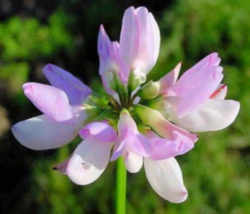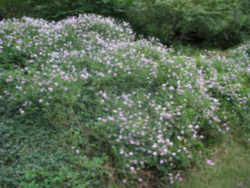Pennsylvania State Beautification and Conservation Plant
Penngift Crownvetch

(Coronilla varia l., Penngift)
Adopted on June 17, 1982.
The Conservation Plant, (Coronilla varia l.,) Penngift Crownvetch, was adopted on June 17, 1982.
Since the late 1950s, a profusion of white and lavender blossoms has trimmed the edges of Pennsylvania highways. Scientists at Penn State University developed the hearty Crownvetch to use as a groundcover for erosion control. The versatile plant is also of value to agribusiness as a feed for livestock.
Pennsylvania Beautification &
Conservation Plant
Crownvetch
Plant

Crownvetch, (Coronilla varia L.,) is a cool season, hardy, perennial legume. It is not a true vetch, although it resembles common and hairy vetch. Crownvetch is a spreading, long-lived, winter-hardy, drought- tolerant, herbaceous legume with angular stems that grow to a height of 2 to 3 feet during the blooming period, after which the plant forms a dense mat about a foot deep. It will grow at fertility levels so low that few other plants will normally survive. Crownvetch spreads from rhizomes and will form a dense cover. It has been used for soil stabilization and as an ornamental for many years. Its principal use is for erosion control, soil building, and ground cover (Hawk 1955, Musser et al. 1954, Richardson and Diseker 1963, and Richardson et al. 1963). It is especially valuable for holding banks along highways. The stand improves with age and gradually chokes out other weeds. It is also used for its ornamental value on steep banks and hillsides (Grau 1962). The plant can be established from seeds or crowns (Wheeler and Hill 1957*).
Inflorescence
Crownvetch produces attractive rose, white, or pinkish-white flowers from June to September. The inflorescence is a contracted raceme, and its flowers are a source of both nectar and pollen, which bees gather. The nectar is not secreted in the usual place but on the outside of the fleshy calyx, where it is sought out by bees (Muller 1883*). They alight upon the petals in the normal manner and probe with their proboscis between the bases of the petals to the outside of the flower for the nectar on the calyx (Knuth 1908*, p. 313, and Muller 1883*). Anderson (1958) stated that the honey bee has to learn how to trip crownvetch blossoms to obtain pollen, the primary attractiveness of the flowers, and, incidentally, to pollinate the blossoms.
Adaptation
Crownvetch has a wide range of climatic adaptations, but its performance has been superior on well-drained soils. It is tolerant of both low pH
and low fertility soils. However, it is highly responsive to lime, phosphorus and potassium.
Crownvetch is particularly adapted to road bank stabilization and erosion control. At the present time this seems to be one of the best uses for the
plant.
Acceptability and nutritive value as a forage crop
In recent years crownvetch has been considered as a source of forage for livestock. Information about the acceptability and nutritive value of crownvetch
is still limited, and there is not enough evidence to make a dependable statement as to its merits as a forage crop. It is a non-bloating legume. Some
research has indicated that the young growth is palatable but that more mature growth is not readily accepted. In other grazing trials, animals were
slow to accept it, but after a few days their performance on crownvetch was comparable to that of other common grass-legume pastures.
Chemical analysis of crownvetch hay has shown that its crude protein and crude fiber content is similar to that of other legume hays. Digestible dry
matter of crownvetch hay was below that of other grass-legume hays harvested at the same stage of maturity. Crownvetch hay is often difficult to wilt
and cure.
Varieties
There are three varieties of crownvetch available. They are Emerald, Penngift and Chemung. Seedlings of Chemung and Emerald are more vigorous than Penngift. Chemung and Emerald usually have taller growth, coarser stems and broader leaves than Penngift. Emerald is well adapted to the soil and climatic conditions of the Midwest, but Chemung appears to be better adapted than Emerald to low fertility sites in the Northeast.
Inoculation
Crownvetch has not been extensively grown, and seed should always be inoculated before seeding. A specific strain of bacteria is required for proper inoculation of crownvetch. This can usually be obtained at the source where seed is obtained. Crownvetch seeds are very small and smooth.
Pennsylvania Senate Bill No. 1042 - 1981
THE GENERAL ASSEMBLY OF PENNSYLVANIA
SENATE BILL
No. 1042 Session of 1981
INTRODUCED BY MANBECK, O'CONNELL, HELFRICK, KELLEY AND CORMAN,
SEPTEMBER 11, 1981
REFERRED TO TRANSPORTATION, SEPTEMBER 11, 1981
AN ACT
Declaring and adopting Penngift Crownvetch (Coronilla Varia L. Penngift) as the State Beautification and Conservation Plant of Pennsylvania.
WHEREAS, Penngift Crownvetch has provided Pennsylvania with world-wide recognition as the "Crownvetch Capitol"; and
WHEREAS, Penngift Crownvetch was first discovered in Pennsylvania by Dr. Fred V. Grau in June 1935, extensively researched by the staff of the Pennsylvania
State University and was named Penngift; Penn for Pennsylvania and Gift for the farmer on whose farm the legume was discovered; and
WHEREAS, The Pennsylvania Department of Transportation has successfully utilized this plant along the roadsides of every Interstate Highway throughout
Pennsylvania since 1958 and receives hundreds of congratulatory letters from the motoring public on the roadside beauty created by Crownvetch; and
WHEREAS, Penngift Crownvetch has successfully stabilized and prevented erosion on over fifty thousand acres of erodible soils and is recognized by
conservationists as a major plant speciesin the reestablishment of vegetation on subsoils; and
WHEREAS, Penngift Crownvetch is well recognized for its agronomic value as a livestock feed and use as a ground cover for erosion control, nitrogen
feeding and soil insulation in no-till corn production.
The General Assembly of the Commonwealth of Pennsylvania
7 hereby enacts as follows:
Section 1. Penngift Crownvetch (Coronilla varia L. Penngift) is hereby selected, designated and adopted as the official State Beautification and Conservation
Plant of the Commonwealth of Pennsylvania.
Section 2. This act shall take effect in 60 days.
Taxonomic Hierarchy: Penngift Crownvetch
Kingdom: Plantae - Plants
Subkingdom: Tracheobionta - Vascular plants
Superdivision: Spermatophyta - Seed plants
Division: Magnoliophyta - Flowering plants
Class: Magnoliopsida - Dicotyledons
Subclass: Rosidae -
Order: Fabales -
Family: Fabaceae - Pea family
Genus: Coronilla L. - crownvetch
Species: Coronilla varia L. - purple crownvetch
Subspecies: Coronilla varia L, Penngift








